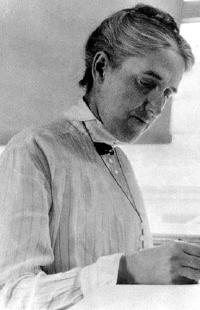Henrietta Swan Leavitt
Radcliffe College (B.S.)
Astronomy
1892
astronomy, observational astronomy, variable stars, novae
Introductory Astronomy, Galactic Astronomy, Stellar Astrophysics, Women in Science
https://en.wikipedia.org/wiki/Henrietta_Swan_Leavitt
G
Scientist Biography
Biographical information
Henrietta Swan Leavitt was born in 1868 in Massachusetts. She attended Radcliffe College which was Harvard's School for Women at the time. Radcliffe College was a liberal Arts college so Leavitt studied a variety of subjects, including math, art, philosophy, and language. It was not until her final year of study that she took a course on astronomy at the Harvard College Observatory. Leavitt then became a volunteer as a research assistant at the Harvard College Observatory where she would become a 'computer.' In this role, Leavitt analyzed the data from the telescopes that she was not allowed to operate. Leavitt studied variable stars, which are stars that vary in brightness over time. From this work studying variable stars, she deduced that many variable stars have a relationship (now called the Leavitt Law) between the star's period of dimming and the star�s intrinsic brightness. This measurement can then be used to determine the distance between the Earth and the star, which otherwise is extremely difficult to measure. Leavitt began to lose her hearing at age 17 due to an illness, becoming deaf in her adult life. At Harvard College Observatory, she worked closely with Annie Jump Cannon, another deaf astronomer. She died at 53 years old from cancer on December 12, 1921.
Research Areas:
astronomy, observational astronomy, variable stars, novaeRelevant Courses:
Introductory Astronomy, Galactic Astronomy, Stellar Astrophysics, Women in ScienceKey Contributions
The period-luminosity relation was discovered by Henriretta Swan Leavitt in 1908 when studying Cepheids, which are stars that periodically dim and brighten. These Cepheids that Leavitt observed were located in the Large and Small Magellanic Clouds. It was seen that the brighter the Cepheids were, the longer it took for the Cepheids to complete a full cycle of dimming and brightening. This relationship provides one of the best ways to measure the absolute magnitude (i.e., the intrinsic brightness) of star, which can then be combined with the apparent magnitude (i.e., the brightness it appears from Earth) to determine the distance to the star using the equation m - M = 5 log(d, 10) where d is distance, m is apparent magnitude, and M is absolute magnitude. This method of measuring distances transformed astronomers' understanding of the size and scale of the Universe, helping scientists like Edwin Hubble determine that certain 'spiral nebulae' like Andromeda were actually entire galaxies far outside out Milky Way.
